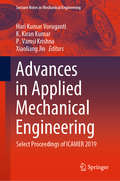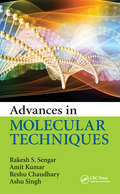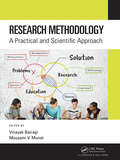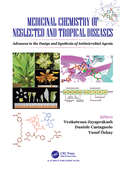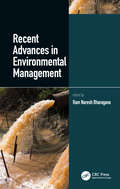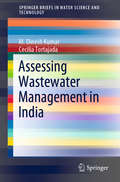- Table View
- List View
Multifunctional Ultrawideband Antennas: Trends, Techniques and Applications
by Chinmoy Saha Jawad Y Siddiqui Y M AntarMultifunctional Antennas (MFA) are comparatively a new area for antenna research and finds applications in various modern wireless radios, like Cognitive Radio (CR) in Software Defined Radio (SDR) technology and MIMO technology. This book is first attempt and an invaluable resource which deals with the design and realization of various kinds of multifunctional antennas. After clearly explaining the exclusive features of MFAs, the book presents various designs of such antennas considering versatile modern and upcoming applications. Written by three internationally known researchers, Multi-Functional Ultra Wideband Antennas: Trends, Techniques and Applications: Provides a lucid introduction on UWB systems, historical perspective and discusses various applications of such systems Discusses fundamentals of antennas and its characterization in time and frequency domains, primarily aimed for the beginners in the area Revisits the design and realization of various classical UWB antennas Discusses various techniques of designing frequency-notched UWB antennas and provide detailed comparison of the techniques Deals with the techniques of deriving multiple antenna functionalities from a single antenna Incorporates exclusive discussions on modern reconfigurable antennas and printed and dielectric resonator based MIMO antennas with clear focus on recent and upcoming technological requirements With Multi-Functional Ultra Wideband Antennas: Trends, Techniques and Applications, antenna engineers, communication system engineers, graduate students, academic/industry researchers will gain a thorough knowledge on design of such antennas with clear physical insight and understanding. Chinmoy Saha, PHD, is an associate Professor in the Department of Avionics at Indian Institute of Space Science and Technology, Thiruvananthapuram, Kerala, India. His current research interest includes Microwave Circuits, Engineered Materials, Metamaterial Inspired Antennas and Circuits, reconfigurable and multi-functional antennas for modern wireless applications, Dielectric Resonator antennas, THz antennas and wireless power transfer. He is the author or coauthor of several books, scientific journals and recipient of several prestigious awards. Jawad Yaseen Siddiqui, PHD, is an associate Professor in the Department of Radio Physics and Electronics at University of Calcutta, Kolkata, India. His current research interest includes ultra-wideband antennas, frequency reconfigurable antennas, tapered slot antennas and multi-functional antennas for cognitive radio application. He is the author or coauthor of several books, scientific journals and recipient of prestigious awards. He is a Co-Principal Investigator on Stratosphere Troposphere (ST) Radar Project at the University of Calcutta, Kolkata, India. Yahia M.M. Antar, PHD, is a Professor in the Department of Department of Electrical and Computer Engineering at the Royal Military College of Canada, Kingston, ON, Canada. He is the author or coauthor of several books, scientific journals and recipient of prestigious awards which includes IEEE-Antennas and Propagation Society prestigious Chen-To-Tai Distinguished Educator Award for 2017, 2015 IEEE Canada J. M. Ham outstanding Engineering Education Award, 2014 IEEE Canada RA Fessenden Silver Medal, 2012 Queen’s Diamond Jubilee Medal from the Governor General of Canada and many more.
Computational Immunology: Basics
by Shyamasree GhoshThe immune system is highly complex system with large number of macromolecules, signaling pathways, protein-protein interactions, and gene expressions. Studies from genomics, transcriptomics, metabolomics are generating huge high throughput data that needs to be analyzed for understanding the Immune system in Health and Disease. Computational approaches arehelping in understanding the study of complex biology of immunology and thereby enabling design of therapeutic strategies in diseases like infectious diseases, immunodeficiency, allergic, hypersensitive, autoimmune disorders and diseases like Cancer, HIV etc. Computational Immunology: Basics highlights the basics of the immune system and function in health and disease. This book offers comprehensive coverage of the most essential topics, including Overview of Immunology and computational Immunology Immune organs and cells, antigen, antibody, B, cell, T cell Antigen Processing and presentation Diseases due to abnormalities of the immune system Cancer Biology Shyamasree Ghosh (MSc, PhD, PGDHE, PGDBI), is currently working in the School of Biological Sciences, National Institute of Science Education and Research (NISER), Bhubaneswar, DAE, Govt of India, graduated from the prestigious Presidency College Kolkata in 1998. She was awarded the prestigious National Scholarship from the Government of India. She has worked and published extensively in glycobiology, sialic acids, immunology, stem cells and nanotechnology. She has authored several publications that include books and encyclopedia chapters in reputed journals and books.
LC-NMR: Expanding the Limits of Structure Elucidation (Chromatographic Science Series)
by Nina C. GonnellaThe isolation and structural characterization of substances present at very low concentrations, as is necessary to satisfy regulatory requirements for pharmaceutical drug degradants and impurities, can present scientific challenges. The coupling of HPLC with NMR spectroscopy has been at the forefront of cutting-edge technologies to address these issues. LC-NMR: Expanding the Limits of Structure Elucidation presents a comprehensive overview of key concepts in HPLC and NMR that are required to achieve definitive structure elucidation with very low levels of analytes. Because skill sets from both of these highly established disciplines are involved in LC-NMR, the author provides introductory background to facilitate readers’ proficiency in both areas, including an entire chapter on NMR theory. The much-anticipated second edition provides guidance in setting up LC-NMR systems, discussion of LC methods that are compatible with NMR, and an update on recent hardware and software advances for system performance, such as improvements in magnet design, probe technology, and solvent suppression techniques that enable unprecedented mass sensitivity in NMR. This edition features methods to quantify concentration and assess purity of isolated metabolites on the micro scale and incorporates computational approaches to accelerate the structure elucidation process. The author also includes implementation and application of qNMR and automated and practical use of computational chemistry combined with QM and DFT to predict highly accurate NMR chemical shifts. The text focuses on current developments in chromatographic-NMR integration, with particular emphasis on utility in the pharmaceutical industry. Applications include trace analysis, analysis of mixtures, and structural characterization of degradation products, impurities, metabolites, peptides, and more. The text discusses novel uses and emerging technologies that challenge detection limits as well future directions for this important technique. This book is a practical primary resource for NMR structure determination—including theory and application—that guides the reader through the steps required for isolation and NMR structure elucidation on the micro scale.
LC-NMR: Expanding the Limits of Structure Elucidation (Chromatographic Science Series)
by Nina C. GonnellaThe isolation and structural characterization of substances present at very low concentrations, as is necessary to satisfy regulatory requirements for pharmaceutical drug degradants and impurities, can present scientific challenges. The coupling of HPLC with NMR spectroscopy has been at the forefront of cutting-edge technologies to address these issues. LC-NMR: Expanding the Limits of Structure Elucidation presents a comprehensive overview of key concepts in HPLC and NMR that are required to achieve definitive structure elucidation with very low levels of analytes. Because skill sets from both of these highly established disciplines are involved in LC-NMR, the author provides introductory background to facilitate readers’ proficiency in both areas, including an entire chapter on NMR theory. The much-anticipated second edition provides guidance in setting up LC-NMR systems, discussion of LC methods that are compatible with NMR, and an update on recent hardware and software advances for system performance, such as improvements in magnet design, probe technology, and solvent suppression techniques that enable unprecedented mass sensitivity in NMR. This edition features methods to quantify concentration and assess purity of isolated metabolites on the micro scale and incorporates computational approaches to accelerate the structure elucidation process. The author also includes implementation and application of qNMR and automated and practical use of computational chemistry combined with QM and DFT to predict highly accurate NMR chemical shifts. The text focuses on current developments in chromatographic-NMR integration, with particular emphasis on utility in the pharmaceutical industry. Applications include trace analysis, analysis of mixtures, and structural characterization of degradation products, impurities, metabolites, peptides, and more. The text discusses novel uses and emerging technologies that challenge detection limits as well future directions for this important technique. This book is a practical primary resource for NMR structure determination—including theory and application—that guides the reader through the steps required for isolation and NMR structure elucidation on the micro scale.
Computational Immunology: Applications
by Shyamasree GhoshComputational Immunology: Applications focuses on different mathematical models, statistical tools, techniques, and computational modelling that helps in understanding complex phenomena of the immune system and its biological functions. The book also focuses on the latest developments in computational biology in designing of drugs, targets, biomarkers for early detection and prognosis of a disease. It highlights the applications of computational methods in deciphering the complex processes of the immune system and its role in health and disease. This book discusses the most essential topics, including Next generation sequencing (NGS) and computational immunology Computational modelling and biology of diseases Drug designing Computation and identification of biomarkers Application in organ transplantation Application in disease detection and therapy Computational methods and applications in understanding of the invertebrate immune system Shyamasree Ghosh (MSc, PhD, PGDHE, PGDBI) Scientific Officer (F), is currently working in the School of Biological Sciences, National Institute of Science Education and Research (NISER), Bhubaneswar, DAE, Govt of India, graduated from the prestigious Presidency College Kolkata in 1998. She was awarded the prestigious National Scholarship from the Government of India. She has worked and published extensively in glycobiology, sialic acids, immunology, stem cells and nanotechnology. She has authored several publications that include books and encyclopedia chapters in reputed journals and books.
Advances in Applied Mechanical Engineering: Select Proceedings of ICAMER 2019 (Lecture Notes in Mechanical Engineering)
by Hari Kumar Voruganti K. Kiran Kumar P. Vamsi Krishna Xiaoliang JinThis book presents select peer reviewed proceedings of the International Conference on Applied Mechanical Engineering Research (ICAMER 2019). The books examines various areas of mechanical engineering namely design, thermal, materials, manufacturing and industrial engineering covering topics like FEA, optimization, vibrations, condition monitoring, tribology, CFD, IC engines, turbo-machines, automobiles, manufacturing processes, machining, CAM, additive manufacturing, modelling and simulation of manufacturing processing, optimization of manufacturing processing, supply chain management, and operations management. In addition, recent studies on composite materials, materials characterization, fracture and fatigue, advanced materials, energy storage, green building, phase change materials and structural change monitoring are also covered. Given the contents, this book will be useful for students, researchers and professionals working in mechanical engineering and allied fields.
Radio Frequency Micromachined Switches, Switching Networks, and Phase Shifters
by Shiban Kishen Koul Sukomal DeyRadio Frequency Micromachined Switches, Switching Networks, and Phase Shifters discusses radio frequency microelectromechanical systems (RF MEMS)-based control components and will be useful for researchers and R&D engineers. It offers an in-depth study, performance analysis, and extensive characterization on micromachined switches and phase shifters. The reader will learn about basic design methodology and techniques to carry out extensive measurements on MEMS switches and phase shifters which include electrical, mechanical, power handling, linearity, temperature stability, reliability, and radio frequency performance. Practical examples included in the book will help readers to build high performance systems/subsystems using micromachined circuits. Key Features Provides simple design methodology of MEMS switches and switching networks including SPST to SP16T switches Gives an in-depth performance study of micromachined phase shifters. Detailed study on reliability and power handling capability of RF MEMS switches and phase shifters presented Proposes reconfigurable micromachined phase shifters Verifies a variety of MEMS switches and phase shifters experimentally
Radio Frequency Micromachined Switches, Switching Networks, and Phase Shifters
by Shiban Kishen Koul Sukomal DeyRadio Frequency Micromachined Switches, Switching Networks, and Phase Shifters discusses radio frequency microelectromechanical systems (RF MEMS)-based control components and will be useful for researchers and R&D engineers. It offers an in-depth study, performance analysis, and extensive characterization on micromachined switches and phase shifters. The reader will learn about basic design methodology and techniques to carry out extensive measurements on MEMS switches and phase shifters which include electrical, mechanical, power handling, linearity, temperature stability, reliability, and radio frequency performance. Practical examples included in the book will help readers to build high performance systems/subsystems using micromachined circuits. Key Features Provides simple design methodology of MEMS switches and switching networks including SPST to SP16T switches Gives an in-depth performance study of micromachined phase shifters. Detailed study on reliability and power handling capability of RF MEMS switches and phase shifters presented Proposes reconfigurable micromachined phase shifters Verifies a variety of MEMS switches and phase shifters experimentally
Advances in Molecular Techniques
by Amit Kumar Ashu Singh Rakesh S. Sengar Reshu ChaudharyMolecular genetics aims to comprehend biological activity at the gene sub-level. Scientists from different areas of research and applied science can use the standard techniques optimized by molecular biologists.This book serves as a guide that introduces classic molecular biology techniques and advances in molecular and genetic engineering.
West Southwest: Vertebrate Life in Southern California
by Gregory K. PregillWest Southwest: Vertebrate Life in Southern California celebrates an amazingly diverse fauna with description, evolutionary background, geographic insight, and ecological detail. Southern California is a vast region of very different habitats – all with an abundance of unique species of plants and animals and all within a day’s drive. Southern California shares an evolutionary history with other areas of the Southwest, but it has its own identity. The book is not a field identification guide. Instead, the book provides the evolutionary history of species groups, details where the individual species occur and their habitat preferences, and how they avoid the perils of predation and human impact. Key Selling Features: Summarizes the evolutionary background and ecology of southern California’s vertebrates: freshwater fish, amphibians, turtles, snakes, lizards, birds and mammals. Reviews the history of southern California’s biotic communities from the coast to the deserts and their association with other areas of the Southwest. Discusses vertebrate design and how it affects performance and lifestyle. Extends and enhances the content of regional field identification guides. Includes 120 maps, figures and color plates.
Plant microRNAs: Shaping Development and Environmental Responses (Concepts and Strategies in Plant Sciences)
by Célia Miguel Tamas Dalmay Inês ChavesThis book summarizes the latest findings on the functions of microRNAs in the regulation of plant development and responses to the surrounding environment. MicroRNAs are an important class of molecules that can be found in diverse groups of organisms, including plants and animals, and the investigation of their roles is a highly dynamic and “hot” research topic. The respective chapters address four main aspects, namely: microRNA investigation and annotation, the regulatory roles of microRNAs in various developmental processes, in response to abiotic factors, and in the context of biotic stress response regulation. Systematically reviewing the most important findings in this field, the book offers an essential guide for undergraduate and graduate students, teachers, and plant science researchers. Due to the potential applications of microRNAs in crop breeding and plant protection, it also represents a valuable resource for scientists in academia and the private sector alike.
Encyclopedia of Polymer Applications, 3 Volume Set
by Munmaya MishraUndoubtedly the applications of polymers are rapidly evolving. Technology is continually changing and quickly advancing as polymers are needed to solve a variety of day-to-day challenges leading to improvements in quality of life. The Encyclopedia of Polymer Applications presents state-of-the-art research and development on the applications of polymers. This groundbreaking work provides important overviews to help stimulate further advancements in all areas of polymers. This comprehensive multi-volume reference includes articles contributed from a diverse and global team of renowned researchers. It offers a broad-based perspective on a multitude of topics in a variety of applications, as well as detailed research information, figures, tables, illustrations, and references. The encyclopedia provides introductions, classifications, properties, selection, types, technologies, shelf-life, recycling, testing and applications for each of the entries where applicable. It features critical content for both novices and experts including, engineers, scientists (polymer scientists, materials scientists, biomedical engineers, macromolecular chemists), researchers, and students, as well as interested readers in academia, industry, and research institutions.
Encyclopedia of Polymer Applications, 3 Volume Set
by Munmaya MishraUndoubtedly the applications of polymers are rapidly evolving. Technology is continually changing and quickly advancing as polymers are needed to solve a variety of day-to-day challenges leading to improvements in quality of life. The Encyclopedia of Polymer Applications presents state-of-the-art research and development on the applications of polymers. This groundbreaking work provides important overviews to help stimulate further advancements in all areas of polymers. This comprehensive multi-volume reference includes articles contributed from a diverse and global team of renowned researchers. It offers a broad-based perspective on a multitude of topics in a variety of applications, as well as detailed research information, figures, tables, illustrations, and references. The encyclopedia provides introductions, classifications, properties, selection, types, technologies, shelf-life, recycling, testing and applications for each of the entries where applicable. It features critical content for both novices and experts including, engineers, scientists (polymer scientists, materials scientists, biomedical engineers, macromolecular chemists), researchers, and students, as well as interested readers in academia, industry, and research institutions.
Research Methodology: A Practical and Scientific Approach
by Vinayak Bairagi Mousami V. MunotThis book offers a design research methodology intended to improve the quality of design research- its academic credibility, industrial significance and societal contribution by enabling more thorough, efficient and effective procedures.
Economics and Management in the Biopharmaceutical Industry in the USA: Evolution and Strategic Change (Routledge Studies in the Economics of Business and Industry)
by Rachel KimFrom a managerial perspective, the biopharmaceutical industry represents a competitive, fast-changing, intellectually-powered, innovation-driven sector. Many management scholars have studied this discontinuous era to make sense of strategic behavior and the cognition of firms and top managers. A past look at the biopharmaceutical industry provides answers to questions that most managers have. For example, what options do you have and what actions do you take when new firms enter your industry? In the 1970s, new biotechnology firms, funded by venture capitalists, appeared in the pharmaceutical industry with new knowledge. Successful pharmaceutical firms decided to collaborate with the new entrants and forge relationships to develop and create new, biotechnology engineered drugs. Thus, the addition of new biotechnology firms ushered in a new business model based on strategic alliances. Strategic alliances have now become an industrial norm called open innovation. The author looks at the historical path of the biopharmaceutical industry, particularly in the United States. While the pharmaceutical industry’s main contributions to society are substantial, there are pressing challenges the industry must face, such as an increase in infectious disease outbreaks or the global aging population, which require new types of care, additionally, mental health care and prescription painkiller addiction are persistent issues with economic repercussions to both federal and local governments. This book presents a holistic view of the biopharmaceutical industry, putting it in a historical context. It will best serve those who are eager to learn about this dynamic, fast-evolving industry and who would like to tackle current biopharmaceutical industry issues in the United States and be prepared for future industry challenges.
Economics and Management in the Biopharmaceutical Industry in the USA: Evolution and Strategic Change (Routledge Studies in the Economics of Business and Industry)
by Rachel KimFrom a managerial perspective, the biopharmaceutical industry represents a competitive, fast-changing, intellectually-powered, innovation-driven sector. Many management scholars have studied this discontinuous era to make sense of strategic behavior and the cognition of firms and top managers. A past look at the biopharmaceutical industry provides answers to questions that most managers have. For example, what options do you have and what actions do you take when new firms enter your industry? In the 1970s, new biotechnology firms, funded by venture capitalists, appeared in the pharmaceutical industry with new knowledge. Successful pharmaceutical firms decided to collaborate with the new entrants and forge relationships to develop and create new, biotechnology engineered drugs. Thus, the addition of new biotechnology firms ushered in a new business model based on strategic alliances. Strategic alliances have now become an industrial norm called open innovation. The author looks at the historical path of the biopharmaceutical industry, particularly in the United States. While the pharmaceutical industry’s main contributions to society are substantial, there are pressing challenges the industry must face, such as an increase in infectious disease outbreaks or the global aging population, which require new types of care, additionally, mental health care and prescription painkiller addiction are persistent issues with economic repercussions to both federal and local governments. This book presents a holistic view of the biopharmaceutical industry, putting it in a historical context. It will best serve those who are eager to learn about this dynamic, fast-evolving industry and who would like to tackle current biopharmaceutical industry issues in the United States and be prepared for future industry challenges.
Medicinal Chemistry of Neglected and Tropical Diseases: Advances in the Design and Synthesis of Antimicrobial Agents
by Venkatesan Jayaprakash Daniele Castagnolo Yusuf OzkayMedicinal Chemistry of Neglected and Tropical Diseases: Advances in the Design and Synthesis of Antimicrobial Agents consolidates and describes modern drug discovery and development approaches currently employed to identify effective chemotherapeutic agents for the treatment of Neglected Tropical Diseases (NTDs) from a medicinal chemistry perspective. Chapters are designed to cater to the needs of medicinal chemists who work with chemotherapeutic developments for NTDs, as well as serve as a guide to budding medicinal chemists who wish to work in this area. It will introduce rational drug design approaches adopted in designing chemotherapeutics and validated targets available for the purpose.
Recent Advances in Environmental Management
by Ram Naresh BharagavaThis book focuses on the toxicity of various organic and inorganic pollutants, their eco-toxicological effects and eco-friendly approaches for remediation of environmental pollutants. Extensive focus has been relied on the recent advances in ecofriendly approaches such as bioremediation and phytoremediation technologies, including the use of various group of microbes for remediation of environmental pollutants, etc. Researchers working in the field of bioremediation, phytoremediation, waste management and related fields will find this compilation most useful for further study to learn about the subject matter.
Epigenetic Processes and Evolution of Life
by Jana Švorcová Anton MarkošThe book covers the possible story of emergence of life and its subsequent evolution, emphasizing the necessary evolutionary step negotiation of a common "language set" which kept all inhabitants in the biosphere together, ensuring a basic level of understanding among them. The book focuses on "protocols of communication" (both genetic and epigenetic) representing norms shared and understood across the whole biosphere, enabling a plethora of holobiotic relationships. Cooperative nature of organismal evolution and epigenetic processes as a major force in evolution are also covered. Topics discussed are illustrated in detail on selected casuistics.
Substrate Analysis for Effective Biofuels Production (Clean Energy Production Technologies)
by Neha Srivastava Manish Srivastava P. K. Mishra Vijai Kumar GuptaAs a substrate, cellulose plays a crucial role in the biomass-based biofuel production process, and is essential to enzyme and sugar production. Accordingly, ensuring maximum availability of cellulose for enzyme production and bioconversion for sugar generation is one of the major challenges for sustainable biofuels production. To date there has been extensive research on biofuel production using lignocellulosic biomass, but there is a huge gap when it comes to the critical analysis of cellulose content, structural feasibility, availability, and economic processing, so that it can be converted for enzyme and fuel production at low cost.Consequently, this book discusses the availability of lignocellulosic substrate for biofuel production in light of the challenges that the biofuels industry is currently facing. After identifying the major substrate selection challenges for the practical biofuel production process, the book addresses said challenges by focusing on various issues such as: potential substrates that have high cellulosic content, structural feasibility, and low-cost & effective processing to remedy the structural complexity of biomass structure and create added value. In addition, it covers recent advancements in cellulase production and outlines future prospects.Given its scope, it offers a valuable guide for research students and industry practitioners alike.
Orchid Biology: Recent Trends & Challenges
by Shaik Mahammad Khasim Sadanand Nagesh Hegde María Teresa González-Arnao Kanchit ThammasiriThis book on “Orchid Biology: Recent Trends & Challenges” reviews the latest strategies for the preservation and conservation of orchid diversity and orchid germplasm. It is an outcome of the Proceedings of the International Symposium on “Biodiversity of Medicinal Plants & Orchids: Emerging Trends and Challenges” held on 9-11 February 2018 at Acharya Nagarjuna University, India. In addition, eminent orchid experts from around the globe were invited to contribute to this book. All chapters were peer-reviewed by international experts. The Orchidaceae are one of the largest families of flowering plants, comprising over 700 genera and 22,500 species and contributing roughly 40 percent of monocotyledons. They also represent the second-largest flowering plant family in India, with 1,141 species in 166 genera, and contribute roughly 10% of Indian flora. Orchids comprise a unique group of plants and their flowers are among the most enchanting and exquisite creations of nature. Phylogenetically and taxonomically, the Orchidaceae are considered to be a highly evolved family among angiosperms. They show incredible diversity in terms of the shape, size and colour of their flowers, and are of great commercial importance in floriculture markets around the globe. Millions of cut flowers of Cymbidium, Dendrobium, Cattleya, Paphiopedilum, Phalaenopsis, Vanda etc., besides potted orchid plants, are sold in Western Countries and thus, the orchid cut flower industry has now become a multimillion-dollar business in Europe, the USA and South East Asia. Besides their ornamental value, orchids hold tremendous pharmaceutical potential. Root tubers of Habenaria edgeworthii form an important component of the ‘Astavarga’ group of drugs in Ayurvedic medicine. It is an established fact that tubers of some terrestrial orchids have been used to treat diarrhoea, dysentery, intestinal disorders, cough, cold and tuberculosis. Some orchids, particularly those belonging to the genera Aerides, Arachnis, Cattleya, Cymbidium, Dendrobium, Epidendrum, Oncidium, Paphiopedilum, Phalaenopsis, Renanthera, Vanda etc. have been extensively used to produce internationally acclaimed hybrids. Yet paradoxically, Indian orchids are victims of their own beauty and popularity. As a result, their natural populations have been declining rapidly because of unbridled commercial exploitation in India and abroad. In fact, some orchids are now at the verge of extinction, e.g. Renanthera imschootiana, Diplomeris hirsuta, Paphiopedilum fairrieanum, Cypripedium elegans, Taeniophylum andamanicum etc. Given the global importance of orchids in terms of securing human health and wealth, this comprehensive compilation, prepared by international experts, is highly topical. Its content is divided into five main sections: (I) Cryopreservation & Biotechnology, (II) Orchid Biodiversity & Conservation, (III) Anatomy & Physiology, (IV) Pollination Biology and (V) Orchid Chemicals & Bioactive Compounds. All contributions were written by eminent orchid experts/professors from around the world, making the book a valuable reference guide for all researchers, teachers, orchid enthusiasts, orchid growers and students of biotechnology, botany, pharmaceutical sciences and ethnomedicine. It will be equally valuable for readers from the horticultural industry, especially the orchid industry, agricultural scientists and policymakers.
Assessing Wastewater Management in India (SpringerBriefs in Water Science and Technology)
by M. Dinesh Kumar Cecilia TortajadaThis book highlights the institutional, legal, and policy measures to manage water pollution in India, and discusses how effective they have been in improving the overall quality of the country’s surface and groundwater resources. It also reviews the status of wastewater generation, collection and treatment in urban areas to provide insights into the gaps in wastewater treatment. Further, it offers a detailed analysis of the wastewater treatment systems available and examines the human health impacts of water pollution in the country, as well as the future trajectory of investment in wastewater treatment systems and potential sectors for reuse and recycling of wastewater, briefly assessing the market demand for treated wastewater. Lastly, it investigates the factors influencing the environmental sustainability and economic viability of wastewater treatment as well as future areas of research in the field.
Biophysics of Mitochondria
by Nikolai VekshinIn this monograph, the author -Head researcher at the Institute of Cell Biophysics of Russian Academy of Sciences- discusses the results of his own long-term studies of mitochondria as well as alternative points of view and experiments of other important researchers in the field. The monograph contains the main aspects of mitochondrial research by a number of physical methods: fluorescence spectroscopy, UV-vis spectrophotometry, IR spectroscopy, light-scattering, optical microscopy, fluorescence microscopy, colorimetry, photobleaching, polarography, among others. The monograph is very useful for researchers and graduate students specializing in mitochondrial biophysics, biochemistry, molecular biology and cytology. The book was published in Russian in 2019 by Photon Publishers (Pushchino, Moscow region).
Seafood Safety and Quality (Food Biology Series)
by Latiful Bari Koji YamazakiSeafood Safety and Quality continues to be a major public health issue and its importance has escalated to unprecedented levels in recent years. In this book, major seafood borne diseases and key safety issues are reviewed. In addition, emerging microbial agents, fish toxins and other contaminants including heavy metal; allergy, water safety and related topics are discussed. It also addresses the challenges faced by both developed and developing countries to ensure seafood safety in new seafood products and processing technologies, seafood trade, safety of foods derived from biotechnology, microbiological risks, emergence of new and antibioticresistant pathogens, particularly from emerging pathogens, directing research to areas of high-risk, focus intervention and establishment of target risk levels and target diseases or pathogens. The book serves as a comprehensive resource on the seafood borne diseases and a wide variety of responsible etiologic agents, including bacteria, viruses, parasites, seafood toxins, and environmental toxins. It has been written in a simple manner and should promote the efforts of the scientific community to deliver safe seafood for a better health and environment.
Flow Control Through Bio-inspired Leading-Edge Tubercles: Morphology, Aerodynamics, Hydrodynamics and Applications
by Daniel T. H. New Bing Feng NgThis book describes and explains the basis of bio-inspired, leading-edge tubercles based on humpback whale flippers as passive but effective flow control devices, as well as providing a comprehensive practical guide in their applications. It first discusses the morphology of the humpback whale flipper from a biological perspective, before presenting detailed experimental and numerical findings from past investigations by various experts on the benefits of leading-edge tubercles and their engineering implementations.Leading-edge tubercle designs and functions have attracted considerable interest from researchers in terms of understanding their role in the underwater agility of these whales, and to exploit their flow dynamics in the development of new and novel engineering solutions. Extensive research over the past recent years has demonstrated that the maneuverability of these whales is at least in part due to the leading-edge tubercles acting as passive flow control devices to delay stall and increase lift in the post-stall regime. In addition to the inherent benefits in terms of aerodynamics and hydrodynamics, investigations into leading-edge tubercles have also broadened into areas of noise attenuation, stability and industrial applications.This book touches upon these areas, with an emphasis upon the effects of lifting-surface types, flow regimes, tubercle geometries, lifting-surface stability and potential industrial applications, among others. As such, it features contributions from key experts in the fields of biology, physics and engineering who have conducted significant studies into understanding the various aspects of leading-edge tubercles. Given the broad coverage and in-depth analysis, this book will benefit academic researchers, practicing engineers and graduate students interested in tapping into such a unique but highly functional flow control strategy.




